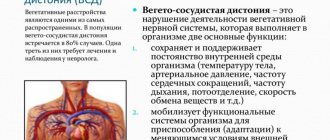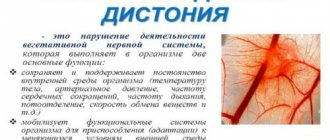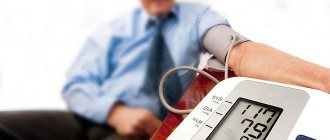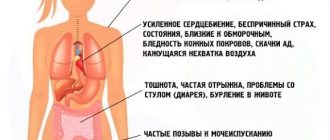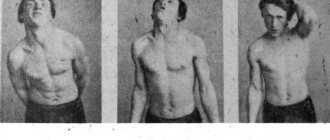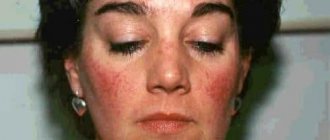Classification of dystonic crises
Vegetative-vascular dystonia occurs due to a violation of vascular tone; its causes may be the following factors:
- periodically experienced stress;
- heredity;
- pathologies in the cervical part of the spinal column;
- skull injuries;
- imbalance of a psychological type.
Important!
Stress and irritability, the inability to relax and gain strength, cause a response from the body, which manifests itself in the development of dystonic crises. Experts identify several types of VSD crises:
- Sympathoadrenal: manifested by pain in the temples, increased blood pressure, discomfort in the chest, rapid heartbeat and anxiety.
- Vagoinsular: expressed in general weakness, nausea, acute lack of air, dizziness. It quickly disappears if a person lies down to rest.
- Hyperventilation: characterized by an acute lack of oxygen, manifested by tachycardia and panic.
- Vegetative-vestibular: manifested by the appearance of pain during a sudden change in body position or posture, as well as active movements.
Panic attacks
During the period of exacerbation of VSD, a person may be seized by a state of panic terror, called a panic attack. A person begins to experience fear that has no basis.
An aggravated course of VSD can cause several types of panic attacks:
- Spontaneous: arising for no apparent reason, without any prerequisites.
- Situational: occurring as a result of the development of certain situations (with a negative ending) that cause an ambiguous reaction in a person.
- Conditional-situational: developing due to a combination of factors, most often caused by hormonal imbalance or alcohol intoxication.
In addition, there are forms in which panic attacks occur:
- Typical, has manifestations in the form of pain in the sternum, increased heart rate, fever and arrhythmia.
- Atypical is characterized by loss of balance, the ability to hear and see, and the onset of fainting.
The periods between the occurrence of an attack and the time without it can vary in time and do not always depend on external factors. This leads to the fact that a person tries to isolate himself from society and spend as little time as possible on the street, among people.
Exacerbations of VSD in different seasons
During the change of seasons, people suffering from vegetative-vascular dystonia are subject to sudden deterioration of their condition, which does not allow them to do their usual activities and requires mandatory consultation with specialists.
Symptoms of VSD in the acute stage have several stages:
- It is characterized by a gradual increase in nervous tension, with the appearance of irrational fear and sharp mood swings.
- It is aggravated by the occurrence of additional symptoms in the form of disorders of the gastrointestinal tract, the occurrence of tachycardia, increased blood pressure and body temperature, and exacerbation of existing headaches.
- It manifests itself as difficulties with focusing vision and the occurrence of dizziness, as well as a combination of other signs of exacerbation of VSD.
It is difficult to answer the question of how long an exacerbation of VSD lasts. The duration of the acute period can be only a few days or take the entire season.
Causes of VSD
Most often, the “roots” of VSD go back to childhood. The tendency to develop an imbalance in the functioning of the ANS is determined, first of all, by heredity, as well as by the earliest stages of child development. Hereditary predisposition is most often transmitted through the maternal line. An unfavorable course of pregnancy and difficult childbirth already at the very beginning of life lay the foundation for the development of VSD.
Throughout life, exposure to a wide variety of provoking factors: infectious processes, chronic diseases, brain damage, hormonal changes, neuroses, stress - leads to the appearance of clinical symptoms of VSD. Hormonal fluctuations can trigger the appearance and exacerbation of symptoms of dystonia. That is why stages of life that are characterized by sudden changes in hormone levels: puberty, pregnancy, the postpartum period, menopause - are often accompanied by numerous manifestations of VSD.
Since hormone fluctuations in the female body occur cyclically (during the menstrual cycle), women are characterized by a more frequent occurrence of VSD, and vegetative crises occur in them 2 times more often than in men. However, the most common cause of autonomic disorders is stress and various neurotic disorders. In this regard, it should be noted that symptoms of VSD may first appear in the postpartum period, which is provoked by lack of sleep, fatigue, and increased physical activity.
Spring exacerbations
Quite often, the course of VSD worsens in the spring, when a climate change occurs, triggering some previously dormant processes in the human body.
The period of spring exacerbation can begin in both March and May. Everything here is strictly individual and difficult to predict.
If vegetative-vascular dystonia worsens in the spring, it is accompanied by the occurrence of the following symptoms:
- panic state;
- emergence or worsening of phobias;
- worsening mood;
- headache;
- increased heart rate;
- temperature increase;
- sudden changes in blood pressure;
- Difficulty performing daily work functions.
A relapse can last for different periods of time, and it depends on the state of the body at a particular point in time.
click to enlarge
Diagnosis of vegetative-vascular dystonia
Due to the fact that, hiding under its masks, VSD can simulate the symptoms of various serious diseases, only a doctor can diagnose dysfunction of the autonomic nervous system, excluding the presence of other pathology.
First of all, the vegetologist excludes damage to the central nervous system - the brain and spinal cord. In addition to a routine neurological examination, complex diagnostic methods such as computed tomography and magnetic resonance imaging may be required for this purpose. In some cases, the similarity of some symptoms of VSD with signs of heart disease and endocrine ailments explains the need to register an electrocardiogram and take blood tests.
Autumn exacerbations
In the treatment and prevention of VSD, taking care of your own health during the onset of autumn, when the body is exposed to many viruses and infections, is of great importance.
During this period, people with VSD exhibit the following symptoms:
- disruption of the proper functioning of internal organs;
- development of prolonged depression;
- elevated temperature during sunrise;
- loss of appetite;
- disruptions in the gastrointestinal tract;
- unreasonable fears during VSD, insomnia developing during this period;
- loss of sensation in the upper and lower extremities.
Winter exacerbations
Vegetative changes can also worsen in winter, when the body does not experience serious shocks. According to experts, it is during this period, if the correct lifestyle is not followed, that exacerbations occur most often.
In winter, people who have worsened vascular dystonia have the question of what to do with the following symptoms:
- more frequent attacks of despondency;
- panic attacks that occur at different times of the day;
- changes in body temperature;
- increased heart rate;
- the occurrence of leg cramps;
- the appearance of breathing difficulties.
conclusions
Exacerbation of vegetative-vascular dystonia is one of the most dangerous and unpleasant manifestations of this disease. They are equally common in children and adults. Often, under the mask of this pathology, other, more serious conditions are hidden. So don't take this diagnosis lightly.
There are many factors that provoke attacks. Most of them can be controlled, thereby reducing their frequency. Following the doctor's recommendations and maintaining a healthy lifestyle significantly improves the well-being of patients.
Summer exacerbations
In the eyes of a layman, an exacerbation of VSD in the summer is unlikely, but in reality, this is not the case. High air temperatures, changes in humidity and increased solar activity negatively affect the body, causing exacerbations.
Manifestations of dystonia in summer are expressed in the occurrence of:
- breathing difficulties;
- pain in the forehead;
- dizziness;
- fainting;
- loss of appetite;
- weight loss;
- disappearance of the desire to move.
General symptoms
With exacerbation of VSD, the symptoms are low-risk. But, when it appears, a decrease in the patient’s quality of life is observed. The pathological process is accompanied by:
- Difficulty breathing;
- Weakness;
- Pain in the heart;
- Drowsiness.
With exacerbation of VSD, the appearance of dizziness and chills is noted. In some patients, the functioning of the digestive tract is disrupted. When the disease occurs, clouding of consciousness is diagnosed.
With an exacerbation of VSD, symptoms manifest themselves in different ways. Experts count more than 150 signs of the pathological process. There are three types of exacerbations. They can be vagoinsular, symptoadrenal and mixed. Depending on the severity, crises can be:
- Light. Their duration is approximately 30 minutes. Pathological conditions are characterized by pronounced symptoms.
- Average. Duration ranges from 30 to 70 minutes. The subsidence of severe symptoms is observed after 24 hours after the end of the crisis.
- Heavy. The duration of the crisis is more than an hour. In this case, severe symptoms and convulsions are observed. After the crisis, the appearance of asthenic syndrome is observed.
How long a crisis can last directly depends on its severity. All types of exacerbations of VSD are accompanied by certain symptoms and clinical manifestations.
It all depends on what reason contributed to the development of the pathological condition. It develops against the background of infectious diseases, acute or chronic stress. A crisis of vegetative-vascular dystonia develops due to external negative influences:
- High air temperatures;
- Irradiation;
- Intoxication;
- Insufficient ventilation in the room, etc.
If an adult smokes, often drinks alcohol or drinks coffee, then he is at risk. An exacerbation of the disease appears after food or chemical poisoning. The pathology is diagnosed in women after excessive physical activity.
An exacerbation of the disease occurs during pregnancy and in the postpartum period. During pregnancy, there is a strong change in hormonal levels. In addition, the woman is very afraid for her child. this leads to sleep disturbances, nausea and vomiting. Pregnancy is accompanied by frequent headaches.
In the third trimester, a woman begins to fear childbirth. This is why apathy, migraines and seizures occur. After the baby is born, symptoms may persist.
It is often accompanied by postpartum depression. This is explained by the fact that a new mother has new responsibilities for caring for a child. An exacerbation of the disease in women is observed during menstruation, as hormonal levels change dramatically and rapidly.
Exacerbation in pregnant women
Pregnancy is a special condition in which the slightest negative symptoms can cause disturbances in the functioning of the entire body. Therefore, it is so important for a woman diagnosed with VSD to monitor her own condition and promptly monitor the occurrence of such dangerous symptoms as:
- depression that lasts for several days and even weeks;
- sleep problems;
- nausea;
- constant fatigue;
- headache.
Click to enlarge
Exacerbation after alcohol intoxication
Alcohol intoxication in itself can seriously undermine a person’s health.
Acute manifestations of VSD in such people are manifested by the following symptoms:
- the appearance of negative emotions and bad thoughts;
- debilitating headaches;
- nausea;
- sudden changes in blood pressure;
- attacks of loss of control over breathing.
click to enlarge
Exacerbations due to stress
When a person is under stress, he feels intense overexcitement caused by increased production of adrenaline. The heart and blood vessels are depleted by such changes, which leads to disruption of their functioning.
Stress exacerbations of VSD are the most severe for the body; they manifest themselves with the following symptoms:
- despondency;
- changes in blood pressure;
- pain in the heart area;
- dyspnea;
- dizziness;
- discomfort in the stomach;
- frequent urination.
Stress is especially common due to lack of sleep while traveling. Moreover, even the use of maintenance medications does not always give the expected effect.
First aid to a patient
It is quite possible to cope with the treatment of a moderate exacerbation of an attack of VSD on your own. You can use the following tools:
light sedatives - naturally, only a doctor can prescribe them;- soothing herbal teas (mint, lemon balm, chamomile, sage, valerian root);
- herbal preparations (tincture of motherwort, valerian, peony).
- relaxing massage;
- meditation;
- walks in the open air;
- adequate sleep and nutrition.
More severe attacks may require medical attention. Especially when symptoms such as heart pain, choking, severe dizziness and loss of consciousness occur. In these cases, it is necessary to call an ambulance, since only specialists can understand the diagnosis and prescribe the correct treatment.
